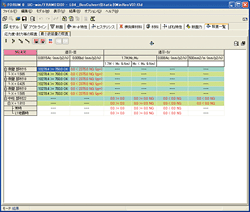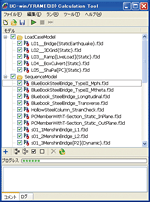
| 3-Dimensional Analysis Program with Solid Frame Structure |
UC-win/FRAME (3D) Ver.3 provides the enhancement for the wide range of function from the analysis part to the cross section calculation part, as well as support of Windows Vista. It attaches a tool with which multi files can be calculated. Revision by functions is as following figure.
|
We have addressed the problem caused from the large scale model consists of many nodes and processing speed of characteristic value analysis has been greatly improved. Around 50 modes to have been calculated are compared in each following case.
|
Large scale matrix (= global stiffness matrix) is created in Solver part. This matrix has the property to have significant value on the diagonal line and have large number of zero on the off diagonal line. Arranging rows and columns to collect values on diagonal line is called reduction of band width. Narrow-band width can process faster, but it costs to process for its optimization. Balance of band width and cost has been considered in this new version.
Math Kernel Library (MKL) provided by Intel Corporation is adopted in the solver part. MKL is designed to recognize the type of CPU automatically to execute optimal data processing. This library has been updated from current Ver.5 to Ver.10 in this time. Improvement of processing speed to solve simultaneous equation has boosted data processing speed 1.2 to 1.7 times faster.
As this product has installed sections database for steel cross section creation, which has extremely been classified and expanded.The specification described in JIS (2006), Design data book (2001/2006) has been supported in this time. And it has also supported the sections developed by some steel maker. This sections database is planned to be installed to "MultiSTEEL", steel structure CAD product, in consultation with MultiSUITE Software.
A checking function of the minimum amount of reinforcement in accordance with Specification for Highway Bridge is added. Checking in accordance with Specification for Highway Bridge III concrete bridge edition and IV substructure edition are available.
 |
 |
The allowable tensile stress of reinforcement (SD295/SD345:100N/mm2) provided in the Specifications for highway bridges has been supported. Checking is available for the allowable bending stress for superstructure members and substructure beam members, which was before inconvenient.
Though this product is assumed axial force and biaxial bending to be always affected in stress calculation, in this version this calculation method has extensively been modified. As a result, this has lead to solve the problem which may fail to convergence depending on the load status. And the calculation time has shortened about three times as fast as before. It will have the effect on the case of large amount of members or load cases.
This product provides five calculation methods for calculation of the effective depth, such as "circle", "oval", "centroid", "neutral axis", and "direct input". "Calculation of d" has been newly prepared, abolishing "centroid" and "neutral axis". "Calculation of d" is simplified to be "d is the distance of compression fibre to the centroid of steel" and is designed to specify the range of steel which is subjected to calculate the centroid of steel.
When cross sections can not resist shear force with only concrete, the necessary area of shear reinforcement bar (Aw) may be calculated or the allowable stress of shear reinforcement bar may be checked. The allowable stress of necessary reinforcement depends on the load or the status of members. Conventional version permitted users to input one type of allowable value, but this has been changed to specify reinforcement materials in this version. This will enable proper allowable value to be used automatically in the program.
Strain checking functions for steel members comply with "earthquake-resistant/damper design guideline for steel bridge", (written and edited by Tsutomu Usami, and edited by Japanese Society of Steel Construction, September 1, 2006, Gihodo) has been enhanced. This allows checking for the steel member modeled with Fibre elements. This function has been extremely improved, although it was installed from ver.2.01.00. (See below)
|
||||||||||||||||||||||||||||||||||
 |
 |
|
 |
||
There is Menogotto- Pinto model as a hysteresis for steels in hysteresis used for Fibre element. (Skelton and internal hysteresis of stress-strain curve). As this model includes parameter RB, which indicates Bauschinger effect, the parameter has been "Rb direct specification only" so far. (See below equation) Three inputs, "Rb0, a1 and a2" have been available in this version.

 |
 |
In response to numerous requests, a linear interpolation of earthquake wave pattern has been supported. Note that the input of small integral time interval leads to the large amount of result data. We recommend that you use it in case of necessary.
It has been added that Import /Export of SDNF (=Steel Detailing Neutral File), which file format is to be a de-facto standard in steel structure business.This will enable UC-win/FRAME (3D) to link with MultiSTEEL. As both of products have same sections database, they provide data exchange each other.


